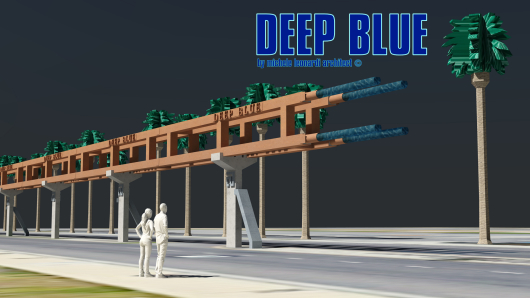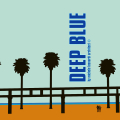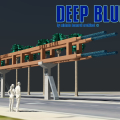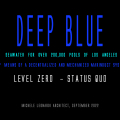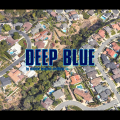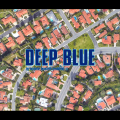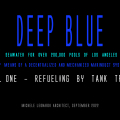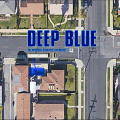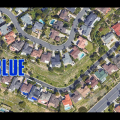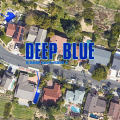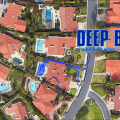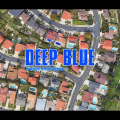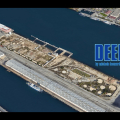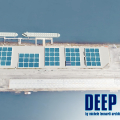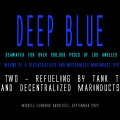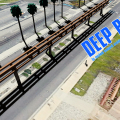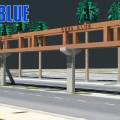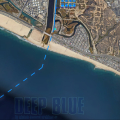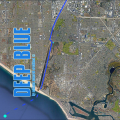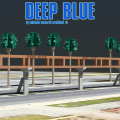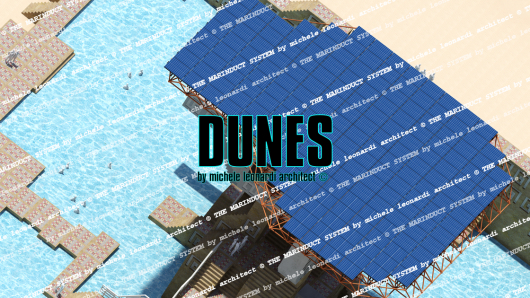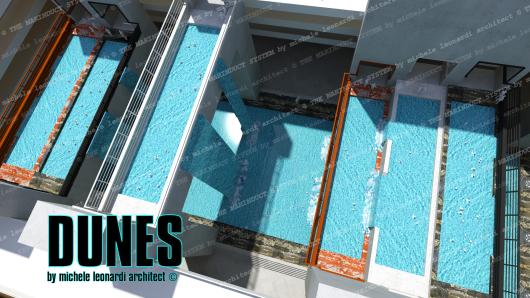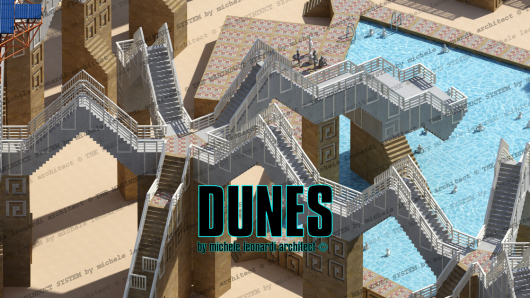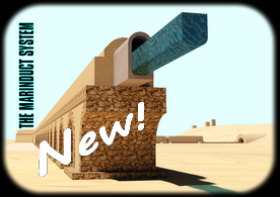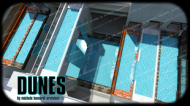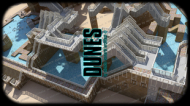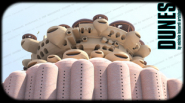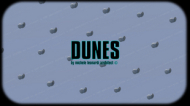Deep Blue
SEAWATER FOR OVER 200,000 SWIMMING POOLS OF
L O S A N G E L E S
BY MEANS OF DECENTRALIZED AND MECHANIZED SYSTEM
by Michele Leonardi architect © September 2022
Link to the video in high definition on YouTube.
THE PROJECT
in broad terms, no details:
LEVEL ZERO
Status quo, the present situation. Some aerial views of Los Angeles, with over 200,000 swimming pools. All background aerial images, as well as the three-dimensional ones, are taken from Google Earth Pro. Design, text, report, rendering and graphics by Michele Leonardi architect © September 2022.
An anticipation of the later implementation of Deep Blue by marinducts.
LEVEL ONE
Refueling of residential swimming pools using natural seawater, transferred to the pools by tank trucks from the exchange terminal (tank trucks – cisterns – tank ships - and marinducts, in a second step) located, for example, in the port of Los Angeles Harbor. Subsequent withdrawal of the "used" seawater from each pool, again by tank trucks, and unloading in the cisterns of the terminal.
THE CYCLE
of seawater use for pool supply:
The seawater is drawn by tank ships off the coast of Los Angeles, in the ocean, away from marine sanctuaries. The tank ships unload the "used" seawater into the ocean and take the "fresh" seawater.
Used, yes, but unpolluted by solvents, detergents or toxic and non-biodegradable substances.
Into the served swimming pools, the evaporated seawater is replaced with other seawater, or in alternative also with fresh water, within a reasonable period of time, i.e. minimizing the use of same fresh water, before being completely removed and replaced with new fresh seawater.
LEVEL TWO
Marinducts will be built at various points in Los Angeles, along axes leading to the hinterland. Along the route of the marinducts, there are in/out cisterns (also underground) for the exchange with the tank trucks; and also at the end of each marinduct. The same is true to small piezometers located where appropriate (and connected to the marinduct system), to lift or pressurize the seawater along the route.
GUIDELINES
1) About the axes of urban penetration of marinduct pipes (above ground) from the coast: By axis we mean a main route, which does not invade the city with its obsessive presence. It is not necessarily always a straight line.
2) The environmental impact must be minimal, almost zero, invisible: along secondary roads, edges of canals, industrial and logistic areas, etc.
3) The final Marinduct network would never be widespread everywhere, door to door.
4) If the decentralized Marinduct network is successful, and after a progression, the final phase it may have underground terminal branches door-to-door distribution routes. But this would be unlikely and also very expensive.
5) Never ever Marinduct pipes (above ground) throughout the city, everywhere.
6) For example: a terminal of a marinduct - that is where tank-trucks refuel with seawater - can be located underground, for example under a parking. And in the meantime the parking lot can be used, because the underground cisterns would be modular, as seen in the project, that is build little by little.
7) The goal is only to reduce the use of fresh water to supply swimming pools by using the seawater during the drought. If the initiative is successful, that is, if all this is pleasing to the people. But if you go from Step 1 to Step 2, it means "Deep Blue" works.
Long Beach, Los Angeles.
LEVEL 3
Over time, seawater could also be used for urban firefighting systems, thalassotherapy (spa), and water funs; see for example on the Systemic Habitats website the following projects by architect Michele Leonardi, all based on the use of seawater: “Stairs in the Water”, “The Roller Coaster of Stairs”, “The Pensile Pools”, “The Great Thermal Baths”.
"Stairs in the Water" by Michele Leonardi architect, a water fun.
"The Pensile Pools" by Michele Leonardi architect, sport and water fun.
"The Roller Coaster of Stairs", another water fun by Michele Leonardi architect.
LEVEL 4
Construction of an off-shore terminal in the sea and a large axis of several underwater pipelines (arranged in parallel: not one large pipeline, but several pipelines of the same diameter; system that can be realized by adding in parallel) lying on the seabed, for the direct supply - i.e. without tankships - of the marinducts network with seawater. With the implementation, tank trucks could be useful one day, except for filling pools of very isolated houses.
The Pacific Ocean in front of Los Angeles Coast, California, U.S.A.
LEVEL 5
Implementation of the Marinduct network, with derivations from Pacific Coast - going up the existing fresh water pathways, aqueducts, open canals, Colorado River, etc. - for transfer in remote places and desalination of seawater by means of solar thermal systems. So: fresh water also for agricultural use. In final, eventually the Marinducts could also reach Las Vegas and Phoenix. Here the natural seawater can be used as it is or desalted.
Also in this case the evaporated seawater of served pools is replaced with other seawater, or in alternative also with fresh water, within a reasonable time frame, i.e. minimizing the use of same fresh water, before being completely removed and replaced with new fresh seawater.
Swimming pools in Las Vegas, Nevada, U.S.A.
The Vanishing River: USA's Mega Drought.
Swimming pools in Phoenix, Arizona, U.S.A.
Geography of Southwestern United States.
There are three big "horizontal" cities, unique in the world, each with over 200,000 swimming pools: Los Angeles, Las Vegas and Phoenix. These "habitat-cities" have enormous potential for implementing quality of life, through a minimal (i.e. "soft") urban renewal, existing culture and natural beauties famous all over the world: architecture, cinema, music, art, literature, fiction, ocean, deserts, national parks, landscapes, mass shows.
A QUESTION
Why not desalinate the seawater and put it in the water supply network?
In principle, yes, but the costs will probably be higher. And above all: sea water has different properties that fresh water does not have. In short, seawater could be perfect for swimming pools, sport, water funs and spa, if this life is not just a Valley of Tears.
LOGISTIC
All other technical specifications, logistics, static and dynamic process etc., are reserved and not reported here, intellectual property of Michele Leonardi architect.
THE ECONOMIC
viability of seawater supply for swimming pools:
Of course if there is no economic return, i.e. a minimum of substantial profit from the entire operation, both in the initial phase and in the subsequent ones, the solution to the problem of how to fill pools with water during the drought emergency is very simple and obvious: any swimming pool will not be damaged if it remains dry during the drought, even if a poll without water is sad. The pool can also be converted into a fire-fighting water tank, equipped with a fire hydrant. It is possible that the people who can spend a lot, they will bring fresh water even from Alaska, if necessary. What else? A quote cannot be missing:
"Water, water, every where,
And all the boards did shrink;
Water, water, every where,
Nor any drop to drink."
From "The Rime of the Ancient Mariner,”
originally published on the "Lyrical Ballads", in 1798,
by Samuel Taylor Coleridge (1772-1834).
M.L.



